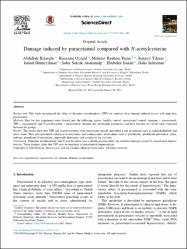Damage induced by paracetamol compared with N-acetylcysteine

Göster/
Erişim
info:eu-repo/semantics/openAccessTarih
2014Yazar
Kısaoğlu, AbdullahÖzoğul, Bünyamin
Turan, Mehmet İbrahim
Yılmaz, İsmail
Demiryılmaz, İsmail
Atamanalp, Sabri Selçuk
Bakan, Ebubekir
Süleyman, Halis
Üst veri
Tüm öğe kaydını gösterKünye
Kisaoglu, A., Özogul, B., Turan, M.I., Yilmaz, I., Demiryilmaz, I., Atamanalp, S.S., Bakan, E., Suleyman, H., (2014).Damage induced by paracetamol compared with N-acetylcysteine.Journal of the Chinese Medical Association, 77(9), 463-468.https://doi.org/10.1016/j.jcma.2014.01.011Özet
Background: This study investigated the effect of thiamine pyrophosphate (TPP) on oxidative liver damage induced in rats with high-dose paracetamol. Methods: Rats for this experiment were divided into the following groups: healthy control, paracetamol control, thiamine + paracetamol, TPP + paracetamol, and N-acetylcysteine + paracetamol. Oxidant and antioxidant parameters and liver function test levels were compared between the groups. Results: the results show that TPP and N-acetylcysteine with paracetamol equally prevented a rise in oxidants such as malondialdehyde and nitric oxide. They also prevented a decrease in enzymatic and nonenzymatic antioxidants such as glutathione, glutathione peroxidase, glutaredoxin, glutathione S-transferase, superoxide dismutase, and catalase in the rat liver. Conclusion: Thiamine pyrophosphate and N-acetylcysteine had a similar positive effect on oxidative damage caused by paracetamol hepatotoxicity. These findings show that TPP may be beneficial in paracetamol hepatotoxicity. Copyright (C) 2014 Elsevier Taiwan LLC and the Chinese Medical Association. All rights reserved.

















